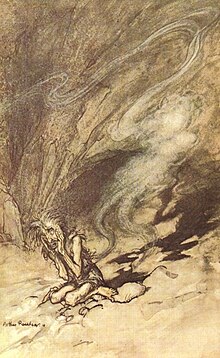Сказка о портном и волшебном плаще
В давние-давние времена, когда еще не было ни телевизоров, ни компьютеров, ни самолетов, ни телефонов, ничего того, что столь привычно современным мальчикам и девочкам.
В те далекие времена, когда люди еще не верили в волшебство, и разные чудеса приключались с ними гораздо чаще, чем сейчас, жил в одной стране герой нашей сказки — портной Себастьян. Он много работал, к нему приходили и богатые и бедные: кому сшить украшенный золотом камзол, кому — нарядное платье, кому — костюм для загородной прогулки. Портной всегда занимался своим делом с большим удовольствием, напевая или насвистывая веселые мелодии.
Однажды Себастьяну заказали сшить плащ. Когда работа была почти закончена, портной решил примерить плащ, чтобы посмотреть, как тот будет на нем сидеть. Себастьян подошел к зеркалу, но не увидел своего отражения! Сначала он не понял, что произошло, но, догадавшись, что все дело в плаще, быстро скинул его с плеч. Подойдя к зеркалу, Себастьян увидел себя в зеркале: румяные щеки, блестящие озорные черные глаза. Портной слышал от своей бабушки, что в году есть несколько волшебных дней и волшебных часов. И если в этот волшебный день и час смастерить какую-либо вещь, то она обязательно будет обладать чудесными свойствами. А откуда вы думаете взялись шапка-невидимка, ковер-самолет, скатерть-самобранка? Просто об этих волшебных днях знают только некоторые посвященные маги и колдуны. А простым людям они неизвестны. Поэтому обыкновенный глиняный горшочек, сотворенный совершенно случайно в волшебное время, начинал сыпать золотыми монетами. Или деревянный конь уносил людей в облака на поиски счастья. Так вот, наш портной Себастьян решил оставить плащ себе.
Он положил в дорожную сумку немного еды, воды, повесил плащ на руку и отправился мир посмотреть. Долго-долго длился его путь. Наконец он устал и расположился под большим раскидистым дубом, что рос у края дороги. Вечерело. Стало прохладно, портной закутался в плащ и заснул беззаботным крепким сном, который бывает только у молодых людей.
С первыми лучами солнца портной проснулся и стал сладко потягиваться. Тут он услышал чей-то разговор. Себастьян огляделся вокруг. Но насколько хватало взгляда, не было ни души, только он и дуб с его обитателями — птицами. Тут портной заметил на нижней ветке дуба пару небольших птичек, которые переговаривались друг с другом. К своему удивлению Себастьян отметил, что понимает птиц, и стал прислушиваться к их разговору. Одна птичка говорила: «Вчера из всех моих яиц вылупились птенцы. Все здоровенькие, желтоватые, и постоянно хотят есть». А вторая отвечала: «А у меня вылупилось только три птенца, а четвертое яйцо — самое большое и разноцветное, почему-то не проклюнулось. Оно холодное и неподвижное». Себастьян полез на дерево и нашел гнездо птицы со странным яйцом. В гнезде оказался камень размером в кулачок девушки. Он был овальный, абсолютно гладкий и удивительно красивый. Портной взял камень в руку, положил его в карман и спустился с дерева. В лучах восходящего солнца он стал разглядывать находку, перекатывая ее в ладони. Камень был весь расписан замысловатыми узорами разных цветов. Себастьян залюбовался такой красотой, как вдруг услышал приближающийся шум. Он положил находку в карман, повесил плащ на руку, поднялся на ноги и стал смотреть на дорогу. По дороге ехали всадники: два рыцаря и их оруженосцы. Себастьян учтиво поклонился, поздоровался и спросил, куда господа держат путь. На что один из рыцарей ответил:
Конец ознакомительного фрагмента.
| Cloak of invisibility | |
|---|---|
| Folk lore and fairy tales element | |

Alberich puts on the Tarnkappe and vanishes; illustration by Arthur Rackham to Richard Wagner’s Das Rheingold |
|
| First appearance | Ancient |
| Genre | Folklore and fairy tales |
| In-universe information | |
| Type | Magical cape |
| Function | Renders the wearer invisible |
A cloak of invisibility is an item that prevents the wearer from being seen. In folklore, mythology and fairy tales, a cloak of invisibility appears either as a magical item used by duplicitous characters or an item worn by a hero to fulfill a quest. It is a common theme in Welsh and Germanic folklore, and may originate with the cap of invisibility seen in ancient Greek myths. The motif falls under «D1361.12 magic cloak of invisibility» in the Stith Thompson motif index scheme.
In folklore[edit]
Cloaks of invisibility are magical items found in folklore and fairy tales. Such cloaks are common in Welsh mythology; a «Mantle of Invisibility» is described in the tale Culhwch and Olwen (c. 1100) as one of King Arthur’s most prized possessions.[1] The mantle is described again, and in more detail,[1] in the Breuddwyd Rhonabwy, and is later listed as one of the Thirteen Treasures of the Island of Britain. A similar mantle appears in the Second Branch of the Mabinogi, in which it is used by Caswallawn to assassinate the seven stewards left behind by Bran the Blessed and usurp the throne.[1][2]
In the English fairy tale Jack the Giant Killer, the hero is rewarded with several magical gifts by a giant he has spared, among them a coat of invisibility. Iona and Peter Opie observe in The Classic Fairy Tales (1974), that Jack’s coat may have been borrowed from the Tale of Tom Thumb or from Norse mythology, but they also draw comparisons with the Celtic stories of the Mabinogion.[3]
The counterpart in Japan is the kakuremino (隠れ蓑), a magical «straw cape» or «raincoat» of invisibility. In the folktale of the «Peach Boy» Momotarō, one of the treasures the hero collects from the ogres is a cape of invisibility, paralleling the story of Jack the giant-slayer.[4]
Tarnkappe[edit]
Although occurrences in fairy tales are rare,[5] the cloak of invisibility appears in the German tale The Twelve Dancing Princesses (KHM 133) and in The King of the Golden Mountain (KHM 92) in Grimm’s Fairy Tales.[6] The cloak in German fairy tales may be traceable to the tarnkappe («cloak of concealment»),[5] such as the one that the hero Sîfrit (Siegfried) acquires from the dwarf Alberich in the Middle High German epic Nibelungenlied.[7] The Grimms clarify that Sîfrit’s kappe is a cape that covers not just the head but enshrouds the body, though in later times tarnkappe came to be regarded as a cap of invisibility. The tarnkappe (or tarnkeppelin[8]) is also owned by the dwarf king who is the title character in Laurin. In different passages or variant manuscripts of these works, the tarnkappe is also referred to as the tarnhût (mod. Ger. Haut «skin»)[7][9] or hehlkappe (mod. Ger. hehlen «to hide»).[10][11]
Modern adaptations[edit]
In the original epic Nibelungenlied, the hero’s cloak not only grants him invisibility, but also increases his strength, to win over the Icelandic queen Brünhild. In Richard Wagner’s opera cycle Der Ring des Nibelungen, the cloak becomes a magic helmet called the Tarnhelm, which also imparts the ability to transform upon its wearer. When Fritz Lang adapted Nibelungenlied for the movie screen in his 1924 film Die Nibelungen, Siegfried uses a veil or net of invisibility gained from the dwarf Alberich.[citation needed]
In fiction[edit]
Raoul Walsh’s film The Thief of Bagdad, was released in the same year as the Die Nibelungen and also features a cloak of invisibility playing a pivotal role.[citation needed]
Edgar Rice Burroughs uses the idea of an invisibility cloak in his 1931 novel A Fighting Man of Mars. The movie Erik the Viking humorously depicts the title character using a cloak of invisibility, which he does not realize apparently works only on elderly men. In The Lord of the Rings, Frodo, and the other members of the Fellowship of the Ring, were given cloaks by the Elves, and Samwise asked, «Are these magic cloaks?» The cloak given to Frodo camouflaged him so that the enemy could see «nothing more than a boulder where the Hobbits were.»[citation needed]
Camouflaging cloaks form a central plot element in Samuel R. Delany’s 1975 novel Dhalgren.[citation needed]
Cloaks of invisibility also exist in the Harry Potter series of novels by J.K. Rowling.[12] Harry Potter uses a Cloak of Invisibility, that was passed down to him by his father, to sneak into forbidden areas of his school and remain unseen. It is later revealed that this specific cloak was once owned by Death himself, making it one of the Deathly Hallows.[citation needed]
In The Secret History by Donna Tartt (1992), the character Richard says, «I became expert at making myself invisible»…»Sunday afternoons, my cloak of invisibility around my shoulders, I would sit in the infirmary for sometimes six hours at a time…»[citation needed]
In science[edit]
On October 19, 2006, a cloak was produced that routed microwaves of a particular frequency around a copper cylinder in a way that made them emerge almost as if there were nothing there. The cloak was made from metamaterials. It cast a small shadow, which the designers hope to fix.
The device obscures a defined two dimensional region and only at a particular microwave frequency. Work on achieving similar results with visible light is in progress.[13][14] Other types of invisibility cloak are also possible, including ones that cloak events rather than objects.
However, cloaking a human-sized object at visible wavelengths appears to have low probability.[15] Indeed, there appears to be a fundamental problem with these devices as «invisibility cloaks»:[16]
It’s not yet clear that you’re going to get the invisibility that everyone thinks about with Star Trek cloaking device or the Harry Potter’s cloak. To make an object literally vanish before a person’s eyes, a cloak would have to simultaneously interact with all of the wavelengths, or colors, that make up light.
On the other hand, a group of researchers connected with Berkeley Lab and the University of California, Berkeley believe that cloaking at optical frequencies is indeed possible. Furthermore, it appears within reach. Their solution to the hurdles presented by cloaking issues are dielectrics. These nonconducting materials (dielectrics) are used for a carpet cloak, which serves as an optical cloaking device.[17][18] According to the lead investigator:
We have come up with a new solution to the problem of invisibility based on the use of dielectric (nonconducting) materials. Our optical cloak not only suggests that true invisibility materials are within reach, it also represents a major step towards transformation optics, opening the door to manipulating light at will for the creation of powerful new microscopes and faster computers.
Furthermore, a new cloaking system was announced in the beginning of 2011 that is effective in visible light and hides macroscopic objects, i.e. objects that can be seen with the human eye. The cloak is constructed from ordinary, and easily obtainable calcite. The crystal consists of two pieces configured according to specific parameters. The calcite is able to refract the light around a solid object positioned between the crystals. The system employs the natural birefringence of the calcite. From outside the system the object is not visible «for at least 3 orders of magnitude larger than the wavelength of light in all three dimensions.» The calcite solves for the limitations of attempting to cloak with metallic inclusions — this method does not require a nanofabrication process as has become necessary with the other methods of cloaking. The nanofabrication process is time-consuming and limits the size of the cloaked region to a microscopic area. The system works best under green light. In addition the researchers appear to be optimistic about a practical cloaking device in the future:[19][20]
In summary, we have demonstrated the first macroscopic cloak operating at visible frequencies, which transforms a deformed mirror into a flat one from all viewing angles. The cloak is capable of hiding three-dimensional objects three to four orders of magnitudes larger than optical wavelengths, and therefore, it satisfies a layman’s definition of an invisibility cloak: namely, the cloaking effect can be directly observed without the help of microscopes. Because our work solves several major issues typically associated with cloaking: size, bandwidth, loss, and image distortion, it paves the way for future practical cloaking devices
Another design calls for tiny metal needles to be fitted into a hairbrush-shaped cone at angles and lengths that would force light to pass around the cloak. This would make everything inside the cone appear to vanish because the light would no longer reflect off it. «It looks pretty much like fiction, I do realize, but it’s completely in agreement with the laws of physics,» said lead researcher Vladimir Shalaev, a professor of electrical and computer engineering at Purdue. «Ideally, if we make it real it would work exactly like Harry Potter’s invisibility cloak,» he said. «It’s not going to be heavy because there’s going to be very little metal in it.»
Furthermore, on April 30, 2009, two teams of scientists developed a cloak that rendered objects invisible to near-infrared light. Unlike its predecessors, this technology did not utilize metals, which improves cloaking since metals cause some light to be lost. Researchers mentioned that since the approach can be scaled down further in size, it was a major step towards a cloak that would work for visible light.[21]
Problems of refraction and opacity[edit]
The headlined claims that laboratory results with metamaterials are demonstrations of prototype invisibility cloaks conflicts with two facts resulting from fundamental characteristics of the underlying metamaterial technology:
- These materials are, by nature, highly dispersive, hence light passing around a «cloaked» object would be strongly refracted (prisms are not invisible).
- Currently light passing through these materials is partially absorbed, making the shield partially opaque.
- Perfect cloaking by materials may be problematic, when taking causality into account.[22]
Acoustic cloaking[edit]
Though perfect cloaking based on invisible paint is impossible if detectors (such as microphones) and sources (such as loudspeakers) are placed round a volume and if a particular formula is used to calculate the signals to be fed to the sources, perfect cloaking is possible. Such perfect cloaking does require that the information can flow through the volume fast enough and the calculations can be performed fast enough so that the necessary information can get to the sources on the far side of the volume fast enough. As a result, perfect cloaking for light is still probably at least very difficult if not impossible. For sound waves, though, such perfect cloaking is possible in principle; an object could therefore be made invisible to sonar, for example.
According to Fermat’s Principle, light follows the trajectory of the shortest optical path, that is, the path over which the integral of the refractive index function is minimal. Therefore, the refractive index of an optical medium determines how light propagates within it. Consequently, by a suitable choice of refractive index profile for an optical medium, light rays can be bent around and made to propagate in closed loops.
See also[edit]
- Acoustic cloak
- Cloaking device
- Invisibility
- Magic ring
References[edit]
- ^ a b c Stephens (1998) p. 479
- ^ Gantz, Jeffrey (1987). The Mabinogion. New York: Penguin. p. 80. ISBN 978-0-14-044322-6.
- ^ Opie, Iona; Opie, Peter (1992) [1974]. The Classic Fairy Tales. Oxford University Press. pp. 47–50. ISBN 978-0-19-211559-1.
- ^ Eberts, Ray E.; Eberts, Cindelyn G. (1995). The myths of Japanese quality. Prentice-Hall. p. 135. ISBN 9780131808034.
- ^ a b Gregorson Campbell, John (2004) [1900], Tatar, Maria (ed.), The Annotated Brothers Grimm, JW. W. Norton & Company, p. 332, ISBN 978-0-393-05848-2
- ^ Jacob & Wilheim Grimm. «The King of the Gold Mountain». Household Tales.
- ^ a b Grimm, Jacob (1883). «XVII. Wights and Elves». Teutonic mythology. Vol. 2. James Steven Stallybrass (tr.). W. Swan Sonnenschein & Allen. p. 462.
- ^ Müllenhoff (1874) ed., Laurin, v. 485
- ^ Ettmüller (1829) ed., Kunech Laurin, v. 39 and note, p. 63
- ^ von der Hagen (1807) ed., Der Nibelungen Lied ms. B 1735, 2614
- ^ Ettmüller (1829) ed.,
- ^ John Schwartz (October 20, 2006). «Scientists Take Step Toward Invisibility». The New York Times.
- ^ Peter N. Spotts (2006-10-20). «Disappear into thin air? Scientists take step toward invisibility». The Christian Science Monitor. Retrieved 2007-05-05.
- ^ Sean Markey (2006-10-19). «First Invisibility Cloak Tested Successfully, Scientists Say». National Geographic News. Retrieved 2007-05-05.
- ^ Robert F. Service & Adrian Cho (17 December 2010). «Strange New Tricks With Light». Science. 330 (6011): 1622. Bibcode:2010Sci…330.1622S. doi:10.1126/science.330.6011.1622. PMID 21163994.
- ^
«Invisibility Cloak Demonstrated!». Computing News. 2006. Retrieved 2007-05-05. - ^ Yarris, Lynn (May 1, 2009). «Blurring the Line Between Magic and Science: Berkeley Researchers Create an «Invisibility Cloak»«. Lawrence Berkeley National Laboratory. Retrieved 2011-03-23.
- ^ Valentine, Jason; Li, Jensen; Zentgraf, Thomas; Bartal, Guy; Zhang, Xiang (2009). «An optical cloak made of dielectrics» (PDF). Nature Materials. 8 (7): 568–71. arXiv:0904.3602. Bibcode:2009NatMa…8..568V. doi:10.1038/nmat2461. PMID 19404237. Archived from the original (PDF) on 2011-10-07. Retrieved 2011-03-23.
- ^ Chen, Xianzhong; Luo, Yu; Zhang, Jingjing; Jiang, Kyle; Pendry, John B.; Zhang, Shuang (2011). «Macroscopic invisibility cloaking of visible light». Nature Communications. 2 (2): 176. arXiv:1012.2783. Bibcode:2011NatCo…2E.176C. doi:10.1038/ncomms1176. PMC 3105339. PMID 21285954.
- ^ Zhang, Baile; Luo, Yuan; Liu, Xiaogang; Barbastathis, George (2011). «Macroscopic Invisibility Cloak for Visible Light». Physical Review Letters. 106 (3): 033901. arXiv:1012.2238. Bibcode:2011PhRvL.106c3901Z. doi:10.1103/PhysRevLett.106.033901. PMID 21405275. S2CID 13851653.
- ^ «Scientists Develop New Invisibility Cloak Technology». redOrbit. April 30, 2009.
- ^ Miller, David A. B. (2006). «On perfect cloaking». Optics Express. 14 (25): 12457–12466. Bibcode:2006OExpr..1412457M. doi:10.1364/OE.14.012457. PMID 19529679.
Bibliography[edit]
- Stephens, Meic, ed. (1998). The New Companion to the Literature of Wales. Cardiff: University of Wales Press. ISBN 978-0-7083-1383-1.
Further reading[edit]
- Cloaking and Invisibility: Fact and Fiction by Professor David R. Smith — Electrical and Computer Engineering — Duke University (May 28, 2006)
- Three-dimensional optical metamaterial with a negative refractive index by Jason Valentine, Shuang Zhang, Thomas Zentgraf, Erick Ulin-Avila, Dentcho A. Genov, Guy Bartal, and Xiang Zhang. Nature advance online publication 11 August 2008.
- Optical Negative Refraction in Bulk Metamaterials of Nanowires by Jie Yao, Zhaowei Liu, Yongmin Liu, Yuan Wang, Cheng Sun, Guy Bartal, Angelica M. Stacy, and Xiang Zhang. Science 15 August 2008: Vol. 321. no. 5891, p. 930.
- Leonhardt, Ulf; Smith, David R (2008). «Focus on Cloaking and Transformation Optics». New Journal of Physics. 10 (11): 115019. Bibcode:2008NJPh…10k5019L. doi:10.1088/1367-2630/10/11/115019.
- Hiding a realistic object using a broadband terahertz invisibility cloak by Fan Zhou, Yongjun Bao, Wei Cao, Colin Stuart, Jianqiang Gu, Weili Zhang, and Cheng Sun. Scientific Reports 1 2011.
- Inami, M.; Kawakami, N.; Tachi, S. (2003). «Optical camouflage using retro-reflective projection technology» (PDF). The Second IEEE and ACM International Symposium on Mixed and Augmented Reality, 2003. Proceedings. pp. 348–349. CiteSeerX 10.1.1.105.4855. doi:10.1109/ISMAR.2003.1240754. ISBN 978-0-7695-2006-3. S2CID 44776407.
- Gonano, C.A. (2016). A perspective on metasurfaces, circuits, holograms and invisibility (PDF). Politecnico di Milano, Italy.
External links[edit]
- Vanishing point — The Guardian Info on «stealth suit»
- Invisibility Cloak Created in 3-D — BBC News
- Invisibility Cloak One Step Closer — BBC News
- How Invisibility Cloaks Work — HowStuffWorks
- Plasmonic invisibility effect — Live Science
- Scientists Aim to Duplicate Harry Potter’s Invisibility Cloak — Live Science
- The invisibility as a result of 4D SEIS field radiation effect
- On The Quest To Invisibility — Metamaterials and Cloaking (video), Prof. Andrea Alù at TEDxAustin, 2013.
| Cloak of invisibility | |
|---|---|
| Folk lore and fairy tales element | |

Alberich puts on the Tarnkappe and vanishes; illustration by Arthur Rackham to Richard Wagner’s Das Rheingold |
|
| First appearance | Ancient |
| Genre | Folklore and fairy tales |
| In-universe information | |
| Type | Magical cape |
| Function | Renders the wearer invisible |
A cloak of invisibility is an item that prevents the wearer from being seen. In folklore, mythology and fairy tales, a cloak of invisibility appears either as a magical item used by duplicitous characters or an item worn by a hero to fulfill a quest. It is a common theme in Welsh and Germanic folklore, and may originate with the cap of invisibility seen in ancient Greek myths. The motif falls under «D1361.12 magic cloak of invisibility» in the Stith Thompson motif index scheme.
In folklore[edit]
Cloaks of invisibility are magical items found in folklore and fairy tales. Such cloaks are common in Welsh mythology; a «Mantle of Invisibility» is described in the tale Culhwch and Olwen (c. 1100) as one of King Arthur’s most prized possessions.[1] The mantle is described again, and in more detail,[1] in the Breuddwyd Rhonabwy, and is later listed as one of the Thirteen Treasures of the Island of Britain. A similar mantle appears in the Second Branch of the Mabinogi, in which it is used by Caswallawn to assassinate the seven stewards left behind by Bran the Blessed and usurp the throne.[1][2]
In the English fairy tale Jack the Giant Killer, the hero is rewarded with several magical gifts by a giant he has spared, among them a coat of invisibility. Iona and Peter Opie observe in The Classic Fairy Tales (1974), that Jack’s coat may have been borrowed from the Tale of Tom Thumb or from Norse mythology, but they also draw comparisons with the Celtic stories of the Mabinogion.[3]
The counterpart in Japan is the kakuremino (隠れ蓑), a magical «straw cape» or «raincoat» of invisibility. In the folktale of the «Peach Boy» Momotarō, one of the treasures the hero collects from the ogres is a cape of invisibility, paralleling the story of Jack the giant-slayer.[4]
Tarnkappe[edit]
Although occurrences in fairy tales are rare,[5] the cloak of invisibility appears in the German tale The Twelve Dancing Princesses (KHM 133) and in The King of the Golden Mountain (KHM 92) in Grimm’s Fairy Tales.[6] The cloak in German fairy tales may be traceable to the tarnkappe («cloak of concealment»),[5] such as the one that the hero Sîfrit (Siegfried) acquires from the dwarf Alberich in the Middle High German epic Nibelungenlied.[7] The Grimms clarify that Sîfrit’s kappe is a cape that covers not just the head but enshrouds the body, though in later times tarnkappe came to be regarded as a cap of invisibility. The tarnkappe (or tarnkeppelin[8]) is also owned by the dwarf king who is the title character in Laurin. In different passages or variant manuscripts of these works, the tarnkappe is also referred to as the tarnhût (mod. Ger. Haut «skin»)[7][9] or hehlkappe (mod. Ger. hehlen «to hide»).[10][11]
Modern adaptations[edit]
In the original epic Nibelungenlied, the hero’s cloak not only grants him invisibility, but also increases his strength, to win over the Icelandic queen Brünhild. In Richard Wagner’s opera cycle Der Ring des Nibelungen, the cloak becomes a magic helmet called the Tarnhelm, which also imparts the ability to transform upon its wearer. When Fritz Lang adapted Nibelungenlied for the movie screen in his 1924 film Die Nibelungen, Siegfried uses a veil or net of invisibility gained from the dwarf Alberich.[citation needed]
In fiction[edit]
Raoul Walsh’s film The Thief of Bagdad, was released in the same year as the Die Nibelungen and also features a cloak of invisibility playing a pivotal role.[citation needed]
Edgar Rice Burroughs uses the idea of an invisibility cloak in his 1931 novel A Fighting Man of Mars. The movie Erik the Viking humorously depicts the title character using a cloak of invisibility, which he does not realize apparently works only on elderly men. In The Lord of the Rings, Frodo, and the other members of the Fellowship of the Ring, were given cloaks by the Elves, and Samwise asked, «Are these magic cloaks?» The cloak given to Frodo camouflaged him so that the enemy could see «nothing more than a boulder where the Hobbits were.»[citation needed]
Camouflaging cloaks form a central plot element in Samuel R. Delany’s 1975 novel Dhalgren.[citation needed]
Cloaks of invisibility also exist in the Harry Potter series of novels by J.K. Rowling.[12] Harry Potter uses a Cloak of Invisibility, that was passed down to him by his father, to sneak into forbidden areas of his school and remain unseen. It is later revealed that this specific cloak was once owned by Death himself, making it one of the Deathly Hallows.[citation needed]
In The Secret History by Donna Tartt (1992), the character Richard says, «I became expert at making myself invisible»…»Sunday afternoons, my cloak of invisibility around my shoulders, I would sit in the infirmary for sometimes six hours at a time…»[citation needed]
In science[edit]
On October 19, 2006, a cloak was produced that routed microwaves of a particular frequency around a copper cylinder in a way that made them emerge almost as if there were nothing there. The cloak was made from metamaterials. It cast a small shadow, which the designers hope to fix.
The device obscures a defined two dimensional region and only at a particular microwave frequency. Work on achieving similar results with visible light is in progress.[13][14] Other types of invisibility cloak are also possible, including ones that cloak events rather than objects.
However, cloaking a human-sized object at visible wavelengths appears to have low probability.[15] Indeed, there appears to be a fundamental problem with these devices as «invisibility cloaks»:[16]
It’s not yet clear that you’re going to get the invisibility that everyone thinks about with Star Trek cloaking device or the Harry Potter’s cloak. To make an object literally vanish before a person’s eyes, a cloak would have to simultaneously interact with all of the wavelengths, or colors, that make up light.
On the other hand, a group of researchers connected with Berkeley Lab and the University of California, Berkeley believe that cloaking at optical frequencies is indeed possible. Furthermore, it appears within reach. Their solution to the hurdles presented by cloaking issues are dielectrics. These nonconducting materials (dielectrics) are used for a carpet cloak, which serves as an optical cloaking device.[17][18] According to the lead investigator:
We have come up with a new solution to the problem of invisibility based on the use of dielectric (nonconducting) materials. Our optical cloak not only suggests that true invisibility materials are within reach, it also represents a major step towards transformation optics, opening the door to manipulating light at will for the creation of powerful new microscopes and faster computers.
Furthermore, a new cloaking system was announced in the beginning of 2011 that is effective in visible light and hides macroscopic objects, i.e. objects that can be seen with the human eye. The cloak is constructed from ordinary, and easily obtainable calcite. The crystal consists of two pieces configured according to specific parameters. The calcite is able to refract the light around a solid object positioned between the crystals. The system employs the natural birefringence of the calcite. From outside the system the object is not visible «for at least 3 orders of magnitude larger than the wavelength of light in all three dimensions.» The calcite solves for the limitations of attempting to cloak with metallic inclusions — this method does not require a nanofabrication process as has become necessary with the other methods of cloaking. The nanofabrication process is time-consuming and limits the size of the cloaked region to a microscopic area. The system works best under green light. In addition the researchers appear to be optimistic about a practical cloaking device in the future:[19][20]
In summary, we have demonstrated the first macroscopic cloak operating at visible frequencies, which transforms a deformed mirror into a flat one from all viewing angles. The cloak is capable of hiding three-dimensional objects three to four orders of magnitudes larger than optical wavelengths, and therefore, it satisfies a layman’s definition of an invisibility cloak: namely, the cloaking effect can be directly observed without the help of microscopes. Because our work solves several major issues typically associated with cloaking: size, bandwidth, loss, and image distortion, it paves the way for future practical cloaking devices
Another design calls for tiny metal needles to be fitted into a hairbrush-shaped cone at angles and lengths that would force light to pass around the cloak. This would make everything inside the cone appear to vanish because the light would no longer reflect off it. «It looks pretty much like fiction, I do realize, but it’s completely in agreement with the laws of physics,» said lead researcher Vladimir Shalaev, a professor of electrical and computer engineering at Purdue. «Ideally, if we make it real it would work exactly like Harry Potter’s invisibility cloak,» he said. «It’s not going to be heavy because there’s going to be very little metal in it.»
Furthermore, on April 30, 2009, two teams of scientists developed a cloak that rendered objects invisible to near-infrared light. Unlike its predecessors, this technology did not utilize metals, which improves cloaking since metals cause some light to be lost. Researchers mentioned that since the approach can be scaled down further in size, it was a major step towards a cloak that would work for visible light.[21]
Problems of refraction and opacity[edit]
The headlined claims that laboratory results with metamaterials are demonstrations of prototype invisibility cloaks conflicts with two facts resulting from fundamental characteristics of the underlying metamaterial technology:
- These materials are, by nature, highly dispersive, hence light passing around a «cloaked» object would be strongly refracted (prisms are not invisible).
- Currently light passing through these materials is partially absorbed, making the shield partially opaque.
- Perfect cloaking by materials may be problematic, when taking causality into account.[22]
Acoustic cloaking[edit]
Though perfect cloaking based on invisible paint is impossible if detectors (such as microphones) and sources (such as loudspeakers) are placed round a volume and if a particular formula is used to calculate the signals to be fed to the sources, perfect cloaking is possible. Such perfect cloaking does require that the information can flow through the volume fast enough and the calculations can be performed fast enough so that the necessary information can get to the sources on the far side of the volume fast enough. As a result, perfect cloaking for light is still probably at least very difficult if not impossible. For sound waves, though, such perfect cloaking is possible in principle; an object could therefore be made invisible to sonar, for example.
According to Fermat’s Principle, light follows the trajectory of the shortest optical path, that is, the path over which the integral of the refractive index function is minimal. Therefore, the refractive index of an optical medium determines how light propagates within it. Consequently, by a suitable choice of refractive index profile for an optical medium, light rays can be bent around and made to propagate in closed loops.
See also[edit]
- Acoustic cloak
- Cloaking device
- Invisibility
- Magic ring
References[edit]
- ^ a b c Stephens (1998) p. 479
- ^ Gantz, Jeffrey (1987). The Mabinogion. New York: Penguin. p. 80. ISBN 978-0-14-044322-6.
- ^ Opie, Iona; Opie, Peter (1992) [1974]. The Classic Fairy Tales. Oxford University Press. pp. 47–50. ISBN 978-0-19-211559-1.
- ^ Eberts, Ray E.; Eberts, Cindelyn G. (1995). The myths of Japanese quality. Prentice-Hall. p. 135. ISBN 9780131808034.
- ^ a b Gregorson Campbell, John (2004) [1900], Tatar, Maria (ed.), The Annotated Brothers Grimm, JW. W. Norton & Company, p. 332, ISBN 978-0-393-05848-2
- ^ Jacob & Wilheim Grimm. «The King of the Gold Mountain». Household Tales.
- ^ a b Grimm, Jacob (1883). «XVII. Wights and Elves». Teutonic mythology. Vol. 2. James Steven Stallybrass (tr.). W. Swan Sonnenschein & Allen. p. 462.
- ^ Müllenhoff (1874) ed., Laurin, v. 485
- ^ Ettmüller (1829) ed., Kunech Laurin, v. 39 and note, p. 63
- ^ von der Hagen (1807) ed., Der Nibelungen Lied ms. B 1735, 2614
- ^ Ettmüller (1829) ed.,
- ^ John Schwartz (October 20, 2006). «Scientists Take Step Toward Invisibility». The New York Times.
- ^ Peter N. Spotts (2006-10-20). «Disappear into thin air? Scientists take step toward invisibility». The Christian Science Monitor. Retrieved 2007-05-05.
- ^ Sean Markey (2006-10-19). «First Invisibility Cloak Tested Successfully, Scientists Say». National Geographic News. Retrieved 2007-05-05.
- ^ Robert F. Service & Adrian Cho (17 December 2010). «Strange New Tricks With Light». Science. 330 (6011): 1622. Bibcode:2010Sci…330.1622S. doi:10.1126/science.330.6011.1622. PMID 21163994.
- ^
«Invisibility Cloak Demonstrated!». Computing News. 2006. Retrieved 2007-05-05. - ^ Yarris, Lynn (May 1, 2009). «Blurring the Line Between Magic and Science: Berkeley Researchers Create an «Invisibility Cloak»«. Lawrence Berkeley National Laboratory. Retrieved 2011-03-23.
- ^ Valentine, Jason; Li, Jensen; Zentgraf, Thomas; Bartal, Guy; Zhang, Xiang (2009). «An optical cloak made of dielectrics» (PDF). Nature Materials. 8 (7): 568–71. arXiv:0904.3602. Bibcode:2009NatMa…8..568V. doi:10.1038/nmat2461. PMID 19404237. Archived from the original (PDF) on 2011-10-07. Retrieved 2011-03-23.
- ^ Chen, Xianzhong; Luo, Yu; Zhang, Jingjing; Jiang, Kyle; Pendry, John B.; Zhang, Shuang (2011). «Macroscopic invisibility cloaking of visible light». Nature Communications. 2 (2): 176. arXiv:1012.2783. Bibcode:2011NatCo…2E.176C. doi:10.1038/ncomms1176. PMC 3105339. PMID 21285954.
- ^ Zhang, Baile; Luo, Yuan; Liu, Xiaogang; Barbastathis, George (2011). «Macroscopic Invisibility Cloak for Visible Light». Physical Review Letters. 106 (3): 033901. arXiv:1012.2238. Bibcode:2011PhRvL.106c3901Z. doi:10.1103/PhysRevLett.106.033901. PMID 21405275. S2CID 13851653.
- ^ «Scientists Develop New Invisibility Cloak Technology». redOrbit. April 30, 2009.
- ^ Miller, David A. B. (2006). «On perfect cloaking». Optics Express. 14 (25): 12457–12466. Bibcode:2006OExpr..1412457M. doi:10.1364/OE.14.012457. PMID 19529679.
Bibliography[edit]
- Stephens, Meic, ed. (1998). The New Companion to the Literature of Wales. Cardiff: University of Wales Press. ISBN 978-0-7083-1383-1.
Further reading[edit]
- Cloaking and Invisibility: Fact and Fiction by Professor David R. Smith — Electrical and Computer Engineering — Duke University (May 28, 2006)
- Three-dimensional optical metamaterial with a negative refractive index by Jason Valentine, Shuang Zhang, Thomas Zentgraf, Erick Ulin-Avila, Dentcho A. Genov, Guy Bartal, and Xiang Zhang. Nature advance online publication 11 August 2008.
- Optical Negative Refraction in Bulk Metamaterials of Nanowires by Jie Yao, Zhaowei Liu, Yongmin Liu, Yuan Wang, Cheng Sun, Guy Bartal, Angelica M. Stacy, and Xiang Zhang. Science 15 August 2008: Vol. 321. no. 5891, p. 930.
- Leonhardt, Ulf; Smith, David R (2008). «Focus on Cloaking and Transformation Optics». New Journal of Physics. 10 (11): 115019. Bibcode:2008NJPh…10k5019L. doi:10.1088/1367-2630/10/11/115019.
- Hiding a realistic object using a broadband terahertz invisibility cloak by Fan Zhou, Yongjun Bao, Wei Cao, Colin Stuart, Jianqiang Gu, Weili Zhang, and Cheng Sun. Scientific Reports 1 2011.
- Inami, M.; Kawakami, N.; Tachi, S. (2003). «Optical camouflage using retro-reflective projection technology» (PDF). The Second IEEE and ACM International Symposium on Mixed and Augmented Reality, 2003. Proceedings. pp. 348–349. CiteSeerX 10.1.1.105.4855. doi:10.1109/ISMAR.2003.1240754. ISBN 978-0-7695-2006-3. S2CID 44776407.
- Gonano, C.A. (2016). A perspective on metasurfaces, circuits, holograms and invisibility (PDF). Politecnico di Milano, Italy.
External links[edit]
- Vanishing point — The Guardian Info on «stealth suit»
- Invisibility Cloak Created in 3-D — BBC News
- Invisibility Cloak One Step Closer — BBC News
- How Invisibility Cloaks Work — HowStuffWorks
- Plasmonic invisibility effect — Live Science
- Scientists Aim to Duplicate Harry Potter’s Invisibility Cloak — Live Science
- The invisibility as a result of 4D SEIS field radiation effect
- On The Quest To Invisibility — Metamaterials and Cloaking (video), Prof. Andrea Alù at TEDxAustin, 2013.
-
Ответы

Вопрос в ТОПку
Ссылка на комментарий

«старик хоттабыч» — ковер самолет был, кажется
-
1
Ссылка на комментарий

Волшебная палочка в Золушке,ковер-самолет в Старике Хоттабыче
-
2
Ссылка на комментарий

Ковер-самолет в сказках «Тысяча и одна ночь»,
Ссылка на комментарий

Ковёр-самолёт ещё в «Волшебная лампа Алладина». Остальное это русские народные сказки, по-моему про конька-горбунка были сапоги, шапка и скатерть.
Ссылка на комментарий

сапоги скороходы-карлик нос. Старик Хотабыч — ковер самолет. Волшебная палока-золушка.
-
1
Ссылка на комментарий

Ска́терть-самобра́нка — волшебная скатерть, фигурирующая в русских народных сказках и написанных по их мотивам литературных произведениях, способная сама себя сервировать. Чтобы накрыть на стол, достаточно развернуть скатерть, и она тут же будет уставлена разнообразными яствами. По окончании трапезы достаточно свернуть грязную посуду и объедки в скатерть — всё исчезнет.
Скатерть-самобранка найдена лешими в сказке о сильном и храбром непобедимом богатыре Иване-царевиче и о прекрасной его супружнице Царь-девице: «стоит только развернуть скатерть, тотчас выпрыгнут из нее двенадцать добрых молодцев да двенадцать красных девиц, принесут разных кушаньев и напитков и начнут потчевать»;
Cтаршая дочь мужика-лешего в сказке «Королевич и его дядька» дарит королевичу в благодарность за спасение отца скатерть-самобранку: «развернул скатерть — чего хочешь, того просишь: и питье и еда».
Ссылка на комментарий

Волшебная палочка еще в Гарри Поттере кстати.
Ссылка на комментарий

Такой магический предмет, как шапка-невидимка часто встречается в народных и авторских сказках. Наверное, людей всегда прельщала перспектива оказаться совершенно невидимым и делать все, что душе угодно. Шапка-невидимка есть в таких сказках:
1. «Девочка с Земли» К.Булычева,
2. «Руслан и Людмила» А.С.Пушкина,
3. Русская народная сказка «Заколдованная королевна» http://ru-skazki.ru/charmed-princess-1&p2.html#8,
4. Русская народная сказка «Безногий и слепой богатыри» http://ru-skazki.ru/legless-and-blind-giants-1&p2.html#7,
5. Русская народная сказка «Вещий сон» http://ru-skazki.ru/prophetic-dream.html#4 ,
6. Русская народная сказка «Ночные пляски» http://rasskajem.ru/nochnyie-plyaski,
7. Арабская сказка «Царица духов и змей».
О сказках, где есть шапка-невидимка http://ru-skazki.ru/?option=com_glossary&id=2273
Ссылка на комментарий

Гугл решает эти задачи за 2 секунды.
-
5
Ссылка на комментарий

Ковер самолет в старике хоттабыче , сапоги — скороходы- карлик нос, скатерть — королевич и его дядька, палка у золушки , шапка по-моему , в царевне -лягушке , нет?)
-
1
Ссылка на комментарий

-
1
Ссылка на комментарий

А не, в царевне нет))) сорри
)
Ссылка на комментарий

правда без волшебной палочки)
Ссылка на комментарий

-
1
Ссылка на комментарий

скороходы в Маленьком муке))
-
2
Ссылка на комментарий

Strawberries, гугл не решил, там просто описываются эти предметы, как и для чего используются, роль в сказках и т.д., да ещё много ссылок на схожие названия но к сказкам отношения не имеющие
Ссылка на комментарий

маринка25
Что то я такую сказку не знаю, сказки нужны известные
Ссылка на комментарий

~mandarinka~, не Гарри Поттера в школе не проходят))
Ссылка на комментарий

А в Руслан и Людмила точно есть шапка -невидимка, что то не припомню. И со скатертью-самобранкой ещё что то нужно, выше упомянутые сказки я вообще не слышала, но помню, что есть какая то известная сказка, сама в детстве читала
Ссылка на комментарий

Мои сказки не подошли????
Ссылка на комментарий

Скатерть в Аленьком цветочке была, когда девица к чудищу попала
Ссылка на комментарий

из них знаю только Руслан и Людмила, просто я думаю, что должны быть какие то известные сказки, которые ребёнок 9 лет мог читать ранее. а там кто их знает, напишем, если других вариантов не будет. Замучили уже этими заданиями по чтению, столько писанины, иногда даже взрослый не всегда разберётся, то по инету ищем.
Ссылка на комментарий

Ссылка на комментарий
Королева Зикси из страны Икс. Волшебный плащ. Сказка Баума читать
Одной лунной ночью на поляне старого леса Бурзи собрались феи.
Полянка была круглой, поросла мягкой, как бархат, травой, а вокруг высились огромные дубы и ели. Если бы кто-то из простых смертных сумел отыскать эту полянку в лесных дебрях, то при свете дня, возможно, ему удалось бы разглядеть маленькие тропинки, протоптанные крошечными ножками волшебных созданий. Во время полнолуния здесь собирались феи и под предводительством своей королевы Лули танцевали и веселились в серебристом свете луны, а их маленькие прозрачные крылышки переливались всеми цветами радуги.
Но в эту ночь никто не танцевал. Королева расположилась на маленьком зеленом бугорке в центре полянки и, когда ее подданные собрались вокруг нее, заговорила с явным неудовольствием в голосе.
— Мне наскучили танцы, дорогие мои, — говорила королева. — С тех пор как Луна сделалась большой и круглой, мы каждую ночь собираемся здесь и танцуем и резвимся, но, хотя все это само по себе замечательно, рано или поздно даже веселье может наскучить. Давайте подумаем, чем еще можно было бы заняться — и получить при этом удовольствие.
— Трудная задача, — подала голос одна из фей, медленно помахивая своими крылышками, словно дама веером. — Мы существуем с незапамятных времен и успели уже попробовать все, что только может прийти в голову. Причем из всех наших развлечений ничто не идет в сравнение с танцами.
— Однако сегодня мне вовсе не хочется танцевать, — возразила королева и немножко нахмурилась.
— Но почему бы нам не попробовать что-нибудь создать с помощью нашего волшебства? — предложила фея, сидевшая у ног королевы.
— Неплохая мысль! — воскликнула Лули, явно приободрившись. — Но что бы такое создать?
— Мне доводилось слышать, что американские феи создали думающую шапку. Всякий смертный, кто надевал ее, начинал вынашивать благородные и удивительные мысли.
— Поистине прекрасное творение! — рассмеялась королева. — Но что стало с этой шапкой?
— Говорят, что человек, получивший ее, очень боялся, что кто-то пожелает ее у него отобрать и сам начнет так же прекрасно мыслить. А потому он спрятал ее так далеко, что потом и сам забыл, где она находится.
— Обидно. Но в таком случае мы не будем делать новую думающую шапку, чтобы и ее не постигла та же участь.
— А я слышала, — подала голос еще одна фея, — о волшебных сапогах, которые всегда уносили того, кто их надевал, подальше от опасности.
— Неплохое подспорье для этих глупых людей, — заметила королева. — Но что стало с сапогами?
— Они достались одному генералу, который и не подозревал об их удивительных свойствах. Однажды он надел их перед сражением, но, вместо того чтобы атаковать противника, он повернул вспять, а за ним и его войско. Победа далась противнику без единого выстрела.
— Но генерал все-таки избежал опасности?
— Опасности-то он избежал, но пострадала его репутация. Он удалился в деревню и совершенно истоптал волшебные сапоги, разгуливая по окрестностям и пытаясь понять, почему же он тогда так струсил.
— Да, сапоги достались не тому, кому следовало бы, — изрекла королева, — и тем самым принесли не радость, но неприятности. Но мы не станем делать такие сапоги. Давайте придумаем что-нибудь другое.
— Может быть, соткать волшебный плащ? — предложила маленькая Эспа, которая до этого помалкивала.
— Плащ? Почему бы и нет? — отозвалась королева. — Но какими чудесными свойствами он будет обладать?
— Пусть тот, кто его наденет, загадает желание — и оно тут же исполнится! — воскликнула Эспа.
Тут со всех сторон послышались возгласы протеста, и королеве пришлось поднять руку, призывая своих подданных к спокойствию.
— Наша сестра просто не подумала о последствиях, когда предложила такой плащ, — обратилась Лули к собравшимся и мило улыбнулась маленькой Эспе, которая сильно огорчилась тому, как было встречено ее предложение. — Но если она немножко поразмыслит, то поймет, что обладатель такого плаща становится столь же могущественным, как и любая из нас. Если я не ошибаюсь, ты хотела подарить этот плащ кому-то из смертных?
— Да, — пробормотала смущенная Эспа.
— Впрочем, мне понравилась эта мысль, — продолжала Лули. — А потому давайте и впрямь изготовим такой плащ, только пусть он исполнит лишь одно желание того, кто его наденет. Думаю, и это доставит беспомощным людям много радости.
— А что, если у плаща будет не один владелец? — поинтересовалась одна из фей. — Означает ли это, что у каждого исполнится по желанию?
Лули на мгновение задумалась, потом сказала:
— Каждый новый владелец плаща получит право на исполнение одного желания — если, конечно, плащ не будет им украден. Плащ не станет выполнять желание вора.
— Значит, плащ исполнит одно желание каждого, кто его наденет? — осведомилась фея, лежавшая у ног королевы.
— Совершенно верно. Если люди будут правильно пользоваться плащом, он принесет им много хорошего. Ну а если окажется, что они используют его для дурных целей, то мы всегда можем отобрать его или лишить волшебной силы. В общем, если все согласны поразвлечься вот таким образом, то давайте приниматься за дело.
Тут феи весело запорхали по полянке, а их повелительница чарующе улыбнулась и махнула волшебной палочкой. Тотчас же в центре полянки появился прекрасный волшебный ткацкий станок. Такими станками простые смертные никогда не пользовались и, возможно, в глаза не видели. Он был из золота и яшмы. У каждой из фей появился в руке серебряный челночок, обмотанный тончайшими и блестящими нитками. Причем на каждом из челночков нитки были особого цвета, отличавшегося от остальных.
Феи трижды обошли хороводом вокруг станка, потом по знаку королевы они приблизились к станку и закрепили концы ниток на его основе. После чего они пустились в пляс, и только серебряные челночки сверкали в их изящных руках; а на станке стала расти тонкая, словно паутинка, ткань.
Королева тоже приняла участие в этой забаве: золотая нить, которая сбегала с ее челночка, и придавала ткани ее волшебные свойства.
Долго трудились веселые феи, и их крошечные ножки выделывали на зеленой траве удивительные па, а их смех звенел, словно серебряные колокольчики, и в темной чащобе старого леса раскатывалось и замирало эхо. Наконец они сделали свое дело и с радостными возгласами стали укладываться на травяном бархате. И челночки, и станок исчезли. Королева Лули стояла в центре полянки и держала в руках волшебный плащ.
Плащ получился на загляденье красивым — он сверкал и переливался всеми цветами радуги. Он был легче лебяжьего пуха и в то же время такой прочный, что никакому силачу не удалось бы порвать его.
Феи с удовольствием взирали на плод своих трудов.
— Какой красивый! — восхищалась маленькая Эспа. — Но кому мы его подарим?
Этот вопрос вызвал множество разных предложений. У каждой феи были свои виды на то, как распорядиться плащом. Все они были знакомы с мужчинами, женщинами и детьми, жившими за большим дремучим лесом, и не стоит удивляться, что разгорелся небольшой спор.
В это время появилась еще одна фея и подошла к королеве.
— Здравствуй, Эреола, — сказала Лули. — Что-то сегодня ты опоздала.
Эреола была очень хороша собой. У нее были мягкие золотистые волосы и большие голубые глаза. Она произнесла тихим и серьезным голосом:
— Да, ваше величество, я опоздала. Но моей вины тут нет. Сегодня вечером скончался старый король Ноландии, покровительницей которого я была со дня его рождения, и я не могла оставить его в смертный час.
— Значит, король Ноландии все-таки скончался, — задумчиво отозвалась королева Лули. — Он был хороший человек, хотя и довольно скучный. Порой, наверное, он сильно утомлял тебя, моя прелестная Эреола.
— Все люди бывают утомительны, — отозвалась со вздохом фея.
— Кто же теперь король Ноландии? — осведомилась Лули.
— В Ноландии сейчас нет короля. Старый монарх умер, не оставив наследника престола. У него вообще нет родственников и, когда я покидала дворец, его пять советников никак не могли решить, что же теперь делать.
— Ну что ж, моя дорогая, отдохни немного, и, я думаю, к тебе скоро вернется прежняя веселость. Я же тем временем подберу для тебя какого-нибудь новорожденного, и тебе не так утомительно будет выполнять свои обязанности. Жаль, тебя сегодня не было с нами. Мы отлично провели время. Смотри, какой чудесный плащ мы соткали.
Эрсола восхищенно разглядывала плащ, а потом спросила:
— Кому же он достанется?
Снова среди фей разгорелся спор, кому из людей подарить эту прекрасную вещь. Королева с улыбкой выслушала самые разные доводы, а потом сказала:
— Полно вам спорить. Давайте лучше спросим Лунного человека. Он следит за нами с большим интересом и однажды, как мне показалось, он лукаво нам подмигнул.
Тут феи обратили свои взоры на небо, и на ровной гладкой поверхности Луны появилось лицо, бородатое и морщинистое, но веселое и добродушное.
— Опять, значит, мне решать ваши споры, — послышался хриплый голос. — Ну да ладно. Что у вас случилось на этот раз?
— Мы хотели бы твоего совета. Кому из простых смертных подарить волшебный плащ, который я соткала с моими фрейлинами? — спросила королева Лули.
— Отдайте его первому несчастному, который вам попадется, — сказал Лунный человек. Счастливчикам ни к чему волшебство. Им и так хорошо. — И с этими словами Лунный человек исчез, а поверхность Луны снова сделалась ровной и блестящей.
Королева радостно захлопала в ладоши.
— Лунный человек очень мудр, — воскликнула она. — Мы именно так и поступим. Поскольку ты, Эреола, сейчас свободна от своих обязанностей феи-покровительницы, отправляйся с этим плащом в Ноландию. Первый несчастный — будь то мужчина, женщина или ребенок — получит этот плащ в дар от нас, фей.
Эреола отвесила поклон и набросила плащ себе на руку.
— Ну что ж, дети мои, — возвестила королева. — Луна вот-вот спрячется за верхушки деревьев, а значит, нам пора расходиться.
Мгновение спустя феи исчезли, и полянка, где они соткали волшебный плащ, погрузилась во тьму.

